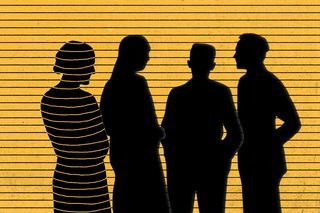
‘Camouflaging’ Can Leave Long‑Term Scars for People on the Autism Spectrum
Hiding one’s natural responses in order to fit in can result in debilitating anxiety and other long-term mental health issues.

2020 has been the best year of my life — for the first time, I didn’t feel the need to pretend to be someone I wasn’t. As an individual on the autism spectrum, I have lived my life oscillating between being ‘different,’ getting judged for it, and reacting by masking my neurodivergence to blend in with a primarily neurotypical society. Social isolation broke this pattern — and suddenly, it became clear to me that most of my struggles were rooted less in my inherent neurodivergence, and more in the pretend-personality I was projecting.
Known as camouflaging, masking, compensation, or adaptive morphing, the conscious or unconscious suppression of natural responses by people on the autism spectrum is aimed at putting on their “best normal” — that is, fitting in, in order to avoid being coddled, babied, ostracized, hated on, harassed, or bullied for being different.
Rakshita, 33, who began camouflaging during her teenage years after realizing people “abhorred her,” said she “would stand for hours in front of the mirror practicing how to smile, how to say hi, how to ask questions. I would prepare scripts — learned from movie songs and from observing my mother — and practice them too.”
Camouflaging encompasses a wide range of behaviors like practicing facial expressions, preparing a list of topics in advance to discuss during social interactions, code-switching, participating in physical formalities like hugs despite being averse to them, and actively avoiding talking about unique personal interests, lest one is labeled “weird.”
Masking their hypersensitivity to stimuli is another challenge that people on the spectrum face. When overwhelmed, “I grip my hands tightly together in front of me — really tightly. I crush the fingers of one hand with the other, to the point that it’s painful. Then I can concentrate on the pain and suppress the urge to run away [and] be seen as rude,” Vanessa Nirode, a writer and woman on the autism spectrum, wrote in 2019.
Related on The Swaddle:
Pandemic Isolation Has Been a Relief for Many Who Don’t Fit into Society’s Norms
Camouflaging can help people on the spectrum blend in in the short term, though it takes a lot of energy. “Once they’re done with camouflaging, they feel an intense need for downtime,” says Mala Chadha, a special educator at Ummeed Child Development Centre (UMDC), a Mumbai-based non-profit that helps children with developmental disabilities.
“I used to be a very quiet girl in school … but at home, I was aggressive, always fighting. My mother took me to psychiatrists and would ask, ‘Why is she an angel at school and a devil at home? Does she hate us?'” Rakshita reminisces. It took her years to understand what was going on. “I know the answer now. I was camouflaging so much at school that by the end of school-time, I was super exhausted mentally. I felt so misunderstood and unwanted that everything seemed to trigger me,” she says.
Long term, however, camouflaging can damage mental health. Rakshita says she wrote “detailed plans” of how to kill herself during her teenage years.
Often, camouflaging leads people to “not have a sense of their identity — not knowing who they are, what their place is in the world. This can be very confusing and impacts one’s relationships, one’s friendships, even one’s career, because they find it difficult to stick with a job, or even a profession,” explains Gopika Kapoor, an autism consultant who has worked with UMDC.
“In the long term, my whole perception of myself is twisted,” says A.B., now 29, who started camouflaging when she was in college. “When you’re acting all the time, you tend to get confused between the character you’re playing, and yourself. And the confusion about who you really are causes a massive amount of anxiety.”
This self-doubt can last for years, according to Chadha. In addition to both generalized and social anxiety, camouflaging can also lead to depression, self-harm, and suicidal tendencies, especially due to “thwarted belonging,” which is defined as “a psychologically painful mental state that results when the fundamental need for connectedness” isn’t met.
Across countries, cultures, and genders, camouflaging takes a toll on people. “As a result of constantly trying to change fundamental aspects of myself … I developed imposter syndrome, extreme self-doubt, and autistic burnout,” Khaaliq, from the U.S., writes in NBC News. He recalls how he “felt like an earthbound alien trying to navigate the arbitrary rules of the culture around me.”
Related on The Swaddle:
I Self‑Diagnosed My Autism Because Nobody Else Would. Here’s Why That Needs to Change.
Camouflaging also prevents people from getting their autism diagnosis, leaving them agonizing for years over why they don’t seem to fit in no matter how hard they try. Research suggests that women camouflage more than men. This finding, in addition to the fact that diagnostic criteria for autism are based on autistic behavior observed in men, presents a ‘double whammy’ for women and individuals who don’t fit into the gender binary, in terms of getting a diagnosis.
But with growing awareness of camouflaging, things are beginning to look up. Moreover, “with the emergence of ‘autistic pride,’ and people on the spectrum taking pride in their neurodivergence, and looking at autism more as a difference than a disorder — the need to fix it is lesser,” Kapoor notes. This slow de-stigmatization of autism could gradually eliminate the need for people to mask who they are, she adds.
However, despite making a conscious decision to accept their neurodivergence, people often struggle to stop camouflaging. A.B. calls it a “default setting” that automatically comes on when she senses her autistic traits not being appreciated or when she’s actively made to feel bad about who she is.
Rakshita shares A.B.’s experience. “The instinct to fit in and safeguard myself kicks in uncomfortably often,” she says. But she’s “determined to heal. I am learning to ask for solitude without guilt, to recognize signs of social excess and take care of myself.”
After years of camouflaging, it takes conscious effort to break away from it during social interactions. At the same time, as Rakshita notes, “even after so much practice, [camouflaging has] not become natural. … It’s a constant intellectual effort.”
Navigating the neurotypical world without losing myself in the process is taxing, especially as I continue to carry the scars of the autistic burnout I experienced a few years ago. And as we gradually ease into a post-lockdown world, with offices opening and social gatherings becoming normal again, I’m scared at the prospect of being judged for being different again — despite having learnt to appreciate my autistic uniqueness. But I am determined to battle my instinct to camouflage in favor of maintaining the sanity social isolation bestowed upon me — and not to sacrifice my true self at the altar of neurotypically acceptable traits again.
Devrupa Rakshit is an Associate Editor at The Swaddle. She is a lawyer by education, a poet by accident, a painter by shaukh, and autistic by birth. You can find her on Instagram @devruparakshit.
Related


What It’s Like To Live With: Hypothyroidism
